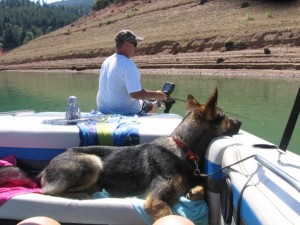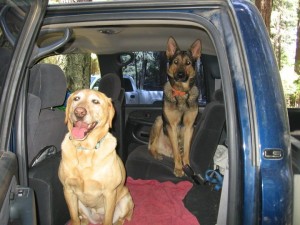Summer Trips
For many families with school-aged children, summer break is just around the corner. Summer vacations can often include family road trips with your family companion and protection dog. There are both urban and rural locations around the U.S. that are very dog friendly, and are well worth considering when planning a vacation. However, there are a few things to keep in mind when planning a family trip that includes your faithful canine companion, particularly during the hot summer months.
Temperature
Dogs are very sensitive to high temperatures. They cannot sweat like humans do to cool themselves down, and instead must rely on panting to help lower their body temperature. Brachiocephalic breeds like Pugs and Boxers are especially vulnerable to overheating, as their unique facial structure makes it more difficult for them to pant effectively.
During summer vacations, give special thought to how your dog will travel. Leaving the dog crated in a truck bed can leave the dog fully exposed to intense solar radiation, with the kennel creating a little “hot box” that can easily overheat your dog. Traveling inside a covered truck bed can also create a dangerously hot situation if proper ventilation is not offered.
Also, never leave your dog inside your car on a warm day, even if you are parked in the shade with the windows open and with water available for the dog! Ambient temperatures of 80 degrees Fahrenheit or more can cause car interior temperatures to climb very quickly, to the point of risking heat stroke and death–even if you are parked in the shade with open windows and are only gone for ‘just a few minutes’. If there is no available shade, even mild temperatures as low as 70 degrees on a sunny day can turn a car into a death trap for a dog.
Local Laws and Regulations
While planning your trip, be sure to check on local laws and regulations regarding your dog. Many areas have strict leash laws, even in dog-friendly cities and camping areas. Some counties are also very strict about leaving animals unattended in vehicles, even for a short period of time. Always bring your dog’s leash and collar with ID tags, and if your dog does not already have permanent identification (like a tattoo or microchip), you should consider getting this done–and registering your dog’s permanent ID with one of the reputable pet recovery companies. You should also bring a copy of your dog’s proof of rabies vaccination or rabies titer. Store this in the glove box or some other easily accessible, safe location. Last but not least, be sure to bring clean-up bags to clean up after your dog. Poop clean-up may not be the most enjoyable part of pet ownership, but neither is it enjoyable to find dog feces on public sidewalks or to step on them while walking through an open grassy area.
First Aid for Dogs
This is especially important if you will be out camping, hiking, or backpacking. Invest in a good, portable first aid kit for dogs to bring with you. A good first aid kit should have a variety of items for cleaning and bandaging cuts and scrapes, as well as supplies for dehydration, bites and stings, allergic reactions, bloat, and pain relief. We will have a future blog on Canine First Aid kits to help you pack that perfect First Aid kit for your canine companion.
Changes in Food and Water
Some dogs are very sensitive to changes in food or water. It is always a wise idea to pack a large jug of water from your home for your dog. This can prevent any water-related digestive upset during traveling. Always pack enough food for your dog, and if you need more while on your trip, try to find the same type. If you feed a raw diet, you have a bit more flexibility, as a quick trip to the meat department of a grocery store easily solves a food shortage problem.
Best wishes to you and your canine companion on your travels!



